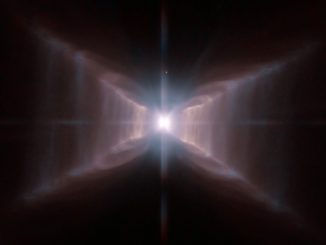
The Magellanic Bridge is a huge intergalactic stream of neutral gas that spans around 75,000 light-years and connects our neighboring galaxies — the Large Magellanic Clouds (LMC) which lie 160,000 light years away, and the Small Magellanic Clouds (SMC) which lie 200,000 light years away. Although scientists have predicted that such a bridge should typically generate its own magnetic field, they have never been able to confirm the existence of such. Until now.
The challenge with cosmic magnetic fields is that they can’t be seen directly. Instead, they can only be detected by observing their effects on surrounding celestial bodies. In this case, the team of researchers — using the Paul Wild Observatory’s Australia Telescope Compact Array — observed radio signals coming from distant galaxies located beyond the LMC and the SMC.
As explained by Jane Kaczmarek, University of Sydney School of Physics PhD student and lead author of the paper: “The radio emission from the distant galaxies served as background ‘flashlights’ that shine through the Bridge. Its magnetic field then changes the polarization of the radio signal. How the polarized light is changed tells us about the intervening magnetic field.”
Similar with a light wave, a radio signal vibrates or oscillates in only one direction or plane. For instance, waves on a pond only move up and down. With a magnetic field present, however, a change happens. Specifically, when a radio signal passes through one, the plane rotates. This movement is referred to as Faraday Rotation — named after Michael Faraday who was the first to discover that light and electromagnetism are related — and through it, scientists are able to measure the strength and polarity (or direction) of the magnetic field.
According to the team, the strength of the magnetic field generated by the Magellanic Bridge was a mere one millionth of the Earth’s own magnetic field. In spite of how small that number may seem, the information may be helpful in figuring out whether it is the bridge that caused the magnetic field to form, or if the field might have resulted from dwarf galaxies interacting with each other. Whatever the case may turn out to be, because we don’t know much about how vast magnetic fields are formed, or what their impact is on the formation and evolution of galaxies, studying the closest one to us may bring us a step closer towards understanding the origin of our own galaxy and how it will evolve.
“Understanding the role that magnetic fields play in the evolution of galaxies and their environment is a fundamental question in astronomy that remains to be answered,” noted Kaczmarek.
The study was recently published in the Monthly Notices of the Royal Astronomical Society and is part of a bigger initiative to build a map of the Universe’s magnetism.
- Bulenox: Get 45% to 91% OFF ... Use Discount Code: UNO
- Risk Our Money Not Yours | Get 50% to 90% OFF ... Use Discount Code: MMBVBKSM
Disclaimer: This page contains affiliate links. If you choose to make a purchase after clicking a link, we may receive a commission at no additional cost to you. Thank you for your support!




Leave a Reply